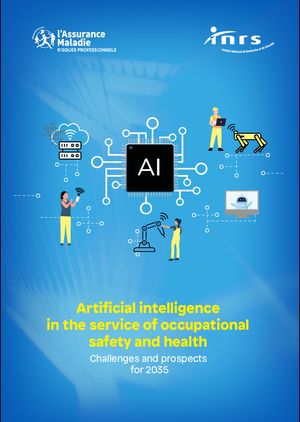KANBrief 4/23

Investment in AI technologies has increased significantly in recent years. Scientific publications show the field of occupational safety and health to be among the potential growth markets for AI. In 2022, the French OSH institute INRS launched a prospective study that examined possible areas of application for AI in occupational safety and health for the period up until 2035.
The purpose of the study was to explore the potential of new AI technologies for the prevention of work-related hazards. It addressed both the benefits of this development, and aspects that must be monitored with particular vigilance. Ultimately, the study was to formulate strategies for action in the field by which the opportunities offered by artificial intelligence for all parties to preventive activity can be exploited to the full.
Three areas of application have been selected as foci of the study:
Technologies that may well contribute indirectly to improving working conditions but primarily serve economic interests have been excluded from the study. This was a recommendation made by a working group of AI experts, company representatives and OSH experts convened specifically for the purpose of the study.
The most important findings of the study have been defined in the form of core messages that are intended to assist OSH experts in gaining a better understanding of the topic and to provide them with tools with which to address future developments.
The key message is that these technologies are of great importance for preventive activity: technologies for recognition based on the analysis of field data have made spectacular progress. This appears to offer considerable potential for the development of systems for safeguarding the working environment. In addition, the automation of certain tasks that is made possible by these technologies may make it unnecessary for employees to perform hazardous tasks in the future.
However, the strategy pursued by developers and distributors of AI systems may deviate considerably from the fundamental values of occupational safety and health acknowledged in France and the rest of Europe. It is important to ensure that during further development of the systems, they are consistent with these values. Since these technologies have yet to prove themselves fully in the field, the OSH community must not rely on them exclusively. Despite all the benefits, a considerable risk also exists of these technologies becoming the focus of work organization for reasons of economic expediency, and of the importance of humane work consequently being sidelined. It should also be borne in mind that occupational accidents often occur in atypical situations, such as during exceptional working conditions, technical malfunctions or maintenance work. AI systems cannot always predict these exceptional circumstances, which limits the scope for their application.
One result of the study is a series of recommendations for action formulated by the working group.
In view of the technical complexity and opacity of AI systems, efforts should be directed first and foremost towards initial and ongoing training of the various parties involved, in order to equip them with comprehensive knowledge of how the systems work, the associated ethical challenges, the legal framework and the possible risks. This initiative should begin at an early stage in the process and should include the parties developing and designing the systems concerned. Training is needed to make these parties aware of the risks associated with the technologies and to urge them to ensure that their algorithms comply with the principles of prevention.
Besides the training measures, particular attention should be paid to the creation of standards and regulations addressing AI technologies. The new arrangements must systematically take into account the principles of occupational safety and health, thereby contributing to the development of safe work equipment.
Finally, particular vigilance is required with regard to the use made of the data that are gathered to enable AI systems to function. The protection of workers’ personal data must be ensured at all times. In addition, the data must be selected and processed in a way that prevents distortions from occurring during the systems’ learning phase.
In summary, it can be said that the advances in AI also open up new perspectives for occupational safety and health, but that at the same time, like any change, they entail risks. Occupational safety and health bodies must therefore not delay in developing and disseminating methodological tools that provide guidance for all parties involved in these innovations.
Jennifer Clerté
INRS
Consultants for future developments and observation
jennifer.clerte@inrs.fr